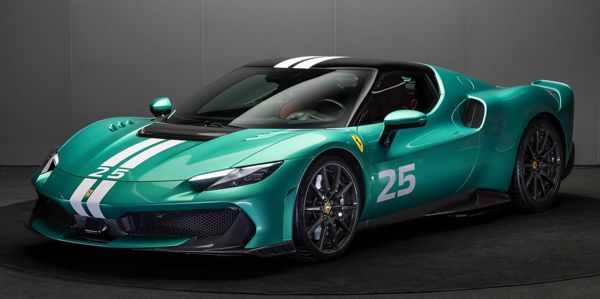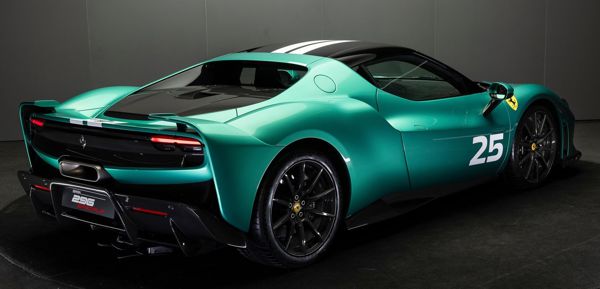
| 30 Apr, 2025 |
| Ferrari
296 Speciale |
 The go-faster version of 296 GTB is called 296 Speciale, reusing the label that appeared before on the 458. Its price climbs by 45 percent to a staggering £350K, yet it is not exactly a limited edition, because it has taken the production line left by the regular GTB which is no longer in production now. Compared with GTB, the Speciale gains 50 horsepower and loses 60 kg of weight (if you tick all the lightweight options, of course). Top speed remains at 205 mph, 0-60 and 0-124 mph are 0.1 and 0.3s quicker, at 2.7 and 7.0 seconds, respectively. Meanwhile, downforce is boosted by 20 percent to 435kg at 155 mph, guaranteeing quicker lap time.  Ferrari talks a lot of transferring the knowledge it learned from the 296 Challenge race car, 499P Le Mans hypercar or the new F80. This starts from the twin-turbo V6 engine, which uses the F80's titanium connecting rods (35 percent lighter than the steel ones on GTB) and strengthened pistons, so that it can withstand higher combustion chamber pressure. Meanwhile, new oil jets improve cooling to the moving parts. The nitrided steel crankshaft is also lightened, so the overall crankshaft assembly (including con-rods and pistons) save 2.2 kg. Like 499P, the engine block and crankcase are machined to remove excess metal. In addition to using titanium bolts, lighter turbos and the aforementioned weight saving measures, the entire engine is trimmed by 9 kg. The V6 employs revised boost management strategy and F1-inspired knock control based on statistical abnormal combustion event. It produces 700 horsepower, 37 hp more than before. The electric motor of the hybrid system is unchanged, but revised control system allows it to produce 180 hp in Qualify mode, 17 hp more than before. Combined output is 880 hp, compared with 830 hp on the GTB.  Ferrari said engine sound is also enhanced, thanks to new acoustic ducts designed by 3D acoustic simulation. Changes to the chassis is relatively modest. The Speciale employs multimatic DSSV dampers, which is available to GTB in Assetto Fiorano package, as standard, along with titanium springs which drops ride height by 5mm, Michelin Cup2 tires with bespoke compounds and an updated ABS. Ferrari talks of 4 percent increase of lateral acceleration and 13 percent cut in body roll, which is not much for a track-oriented model. The entire car tips the scale at 1410kg dry, 60kg less than the base car. Weight saving comes from the engine, more carbon-fiber body parts, carbon-fiber inner door panels and lighter seats.  |
| |
| 23 Apr, 2025 |
| Lexus ES
goes dual-power route |
 This is the new, 8th generation Lexus ES. It makes world debut in Shanghai motor show because China is its largest market - although that is likely to be changed soon. Following the footprints of the outgoing generation, it takes a progressive approach in styling, emphasizing a sleek and coupe-like look. However, you will notice that its waistline has been raised significantly. This is because the new ES accepts both ICE and BEV power, much like BMW does with its CLAR platform models. In battery electric version, the battery packs are placed under the floorpan, so the entire passenger cell is raised together with the roof, which stands as far as 1560mm from the ground. For comparison, the outgoing ES is 1445mm tall.  Apart from taller, the new ES is also much larger. At a massive 5140mm, it is 165mm longer than the old car. Its 1920mm width is 55mm wider, while wheelbase is stretched by 80mm to 2950mm. Apparently, Lexus wants to reposition the ES as its largest sedan offering, effectively replacing the aging LS, which as we know will not get a next generation due to poor sales.  For comfort and space, it might be a feasible replacement to LS, but for performance, luxury and class, I'm afraid not. Take the interior for example, it looks nothing luxurious. A 12.3-inch TFT instrument combines with 14-inch center touchscreen and touch sensitive buttons beneath that are just about business as usual. For sure the ES will remain as a value-oriented alternative to German premium brands.  The same goes for performance. The new car rides on MacPherson struts up front and multi-link at the rear, but there is no mentioning of air suspension. The powertrain has multiple choices, but none of them could be called classy. Entry-level model ES300h runs a tax-friendly 2.0-liter NA engine with hybrid assistance, managing only 197 hp and 0-60 mph in a laughable 8.8 seconds. Fortunately, it is expected to serve China market only. The rest of the world will get ES350h with a 2.5-liter hybrid setup like the outgoing ES, but with output improved slightly to 247 hp. However, pulling a heavier car means 0-60 mph takes 7.4 seconds, hardly impressive. Electric model ES350e uses a front motor to produce merely 224 hp, taking 8.4 seconds to go from 0-60 mph. Dual-motor AWD ES500e is much better at 343 hp and 5.6 seconds, but should be considered slow in the EV world. Lexus has not revealed battery capacity, range or charging speed, so its competitiveness remains a mystery. |
| |
| 1 Apr, 2025 |
| Musk sells
Tesla to China in exchange for TikTok |
 Elon Musk is set to sell Tesla to rising Chinese rival BYD, AutoZine has learned. Tesla is facing its biggest crisis ever. Last year its sales declined for the first time since it started mass production in 2012. Its share price has been halved from the peak last year. Its cars and facilities are under attack at home, while European motorists boycott its cars due to Musk’ intervention in local politics. Moreover, as Cybertruck is proved unpopular and no credible new models to be launched this year aside from the low-volume Robotaxi, there is no sign for revival anytime soon. All these factors drive Musk to consider selling his company to someone who has a lot of money, which turns out to be BYD. BYD is already the largest car maker in China as well as the fastest growing one in the global market. It built 4.3 million cars last year, mostly EVs and plug-in hybrids, more than twice the volume of Tesla. Backed by state-owned Chinese banks, it is believed BYD is the only rival capable of offering a price Musk considers irresistible. Besides money, the deal will include the ownership of Chinese social media TikTok, which is the real interest to Musk who is getting tired of making electric cars. Although TikTok is not owned by BYD, nothing is impossible in China under the direction of government. By acquiring Tesla, BYD will control the company’s assembly plants in Fremont, California and Austin, Texas, plus the Gigafactory in Nevada that produces batteries. This will allow the Chinese automaker to bypass the 25 percent tariffs imposed on foreign-made cars and components, effectively putting BYD in the driving seat when compared with rivals GM and Ford which still rely on factories and suppliers located in Mexico and Canada. BYD aims at leapfrogging GM, Ford, Toyota, Honda and Hyunda-Kia in US sales once the Tesla factories start building BYD models from next year. However, the deal is not inked yet, as BYD demands Musk to use his DOGE (Department of Government Efficiency) know-know to fire all Tesla employees and workers before transferring ownership. They will be replaced with imported Chinese labours with half the salary and double working hours who are exempted from import tariffs. Meanwhile, the entire design and engineering department will be closed as car development will be subcontracted to xAI, keeping the money in Musk’s hands. It is known that President Trump has already expressed support to the deal, and believes it will pave the way for making American car great again. Final agreement is expected to be signed by the next April Fools’ day. |
| |
